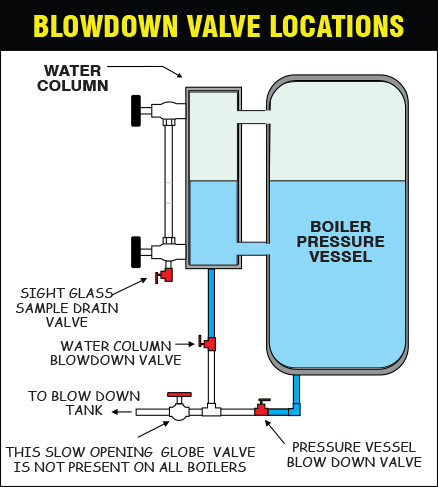There is a long list of impurities in water entering a boiler. However, in the dry cleaning and laundry industries, the major ones affecting the operation of boilers are dissolved solids (known as TDS, or total solids) and oxygen, which is dissolved in the new city water entering the return tank. This oxygen combines with carbon dioxide to form carbonic acid, a destroyer of the metal in the boiler and piping throughout the steam/return systems. The pH indicates the concentration of acids in boiler water (PH is a scale used to specify how acidic or basic [or alkaline] a water-based solution is). Measuring TDS and pH levels indicates the condition of the treated water entering and inside the boiler, allowing proper adjustment of the blowdown frequency as well as the volume and timing of boiler compound addition to the return tank, preventing boiler damage.
ESTABLISHING THE CORRECT BLOWDOWN PROCEDURE
Blowdown and compound addition are the two most important factors in maintaining the proper boiler water chemistry. No matter how efficient the water treatment program, water entering the boiler (feed water) will contain impurities such as salts and suspended and dissolved solids. The process of boiling away water to generate steam leaves these impurities behind, accumulating inside the boiler during daily operations.
Blowdown uses gravity and steam pressure to expel this accumulated debris, detritus, and other impurities before they adhere to and/or corrode the internal surfaces of your boiler and steam system piping. Sometimes, it seems like every boiler manufacturer and/or operator has their own idea about how and when to blow down their boiler.
The recommendations I will be making are based on several years of experience in troubleshooting and repairing boilers of many different manufacturers in arguably the worst area for boiler water impurities in the country. They may differ from those recommended by the boiler manufacturer. When in doubt, follow the manufacturer’s procedure.
WHEN TO BLOWDOWN
Under normal circumstances, two daily blowdowns are sufficient: one in the morning and the other in the early afternoon (Never leave the boiler or return tank empty overnight). While the boiler is shut down, much of the particulate matter, being heavier than water, will settle to the bottom of the boiler in an area where the blowdown is very effective.
The morning blowdown would be shortly after the boiler is started up. Wait until the steam pressure rises to about 30-40 PSI, and then start the blowdown; for the afternoon blowdown, shut down the boiler while you’re still using steam so boiler pressure drops quickly. The blowdown procedure is initiated when boiler pressure drops to about 30-40 PSI.
You will quickly determine the length of time after a blowdown until steam pressure rises sufficiently to resume production. Use this recovery period to calculate the best timing to minimize production loss by timing blowdowns. Hence, recovery occurs during an employee break or lunch period and is shortly after the boiler is started.
Boilers used in dry cleaning and small laundry operations usually have two to four blowdown valve locations. First is the water column, and second is the boiler shell (pressure vessel). There may also be a large slow-opening globe valve and a small valve at the lower end of the sight glass fixture, which can also be used to drain water samples for testing.

HOW TO BLOWDOWN
In addition, the most effective part of the blowdown is during the first several seconds. Therefore, short blowdowns are recommended. Blowdowns of about 15 seconds for the water column, 25 seconds for the boiler shell (pressure vessel), and 5 seconds for the sight glass (if a valve is installed for that purpose).
Locate the valves shown in the illustration. Slowly open the valve and start the timing after the valve is fully open (If the boiler is specified to run at pressures over 80 PSI, there is generally a slow-opening globe valve that must also be open during blowdown).
Blowing all the water out of the boiler and/or draining the return tank and refilling with city water is NOT NECESSARY. It is a waste of water softening capacity and boiler compound. When the blowdown is complete, be sure to reset the valves for normal boiler operation.
Well, that’s it for this month; next month, I’ll be discussing how to measure the level of impurities present in your boiler water using inexpensive TDS and pH meters.

Bruce Grossman
Bruce Grossman is the Chief of R&D for EZtimers Manufacturing. EZtimers is the manufacturer of the new EZ DOSE boiler compound manager and return tank level control which replaces that troublesome ball float valve in the condensate return tank and automatically adds the correct amount of boiler compound to the return tank preventing the oxygen corrosion and scaling. Our SAHARA and DIB-M high purity separator water mister/evaporators provide a thrifty, legal method to get rid of the separator water generated by your dry-cleaning machine. See our Ad in this issue and for further information on EZtimers products visit www.eztimers.com Please address any questions or comments for Bruce to bruce@eztimers.com or call 702-376-6693.

